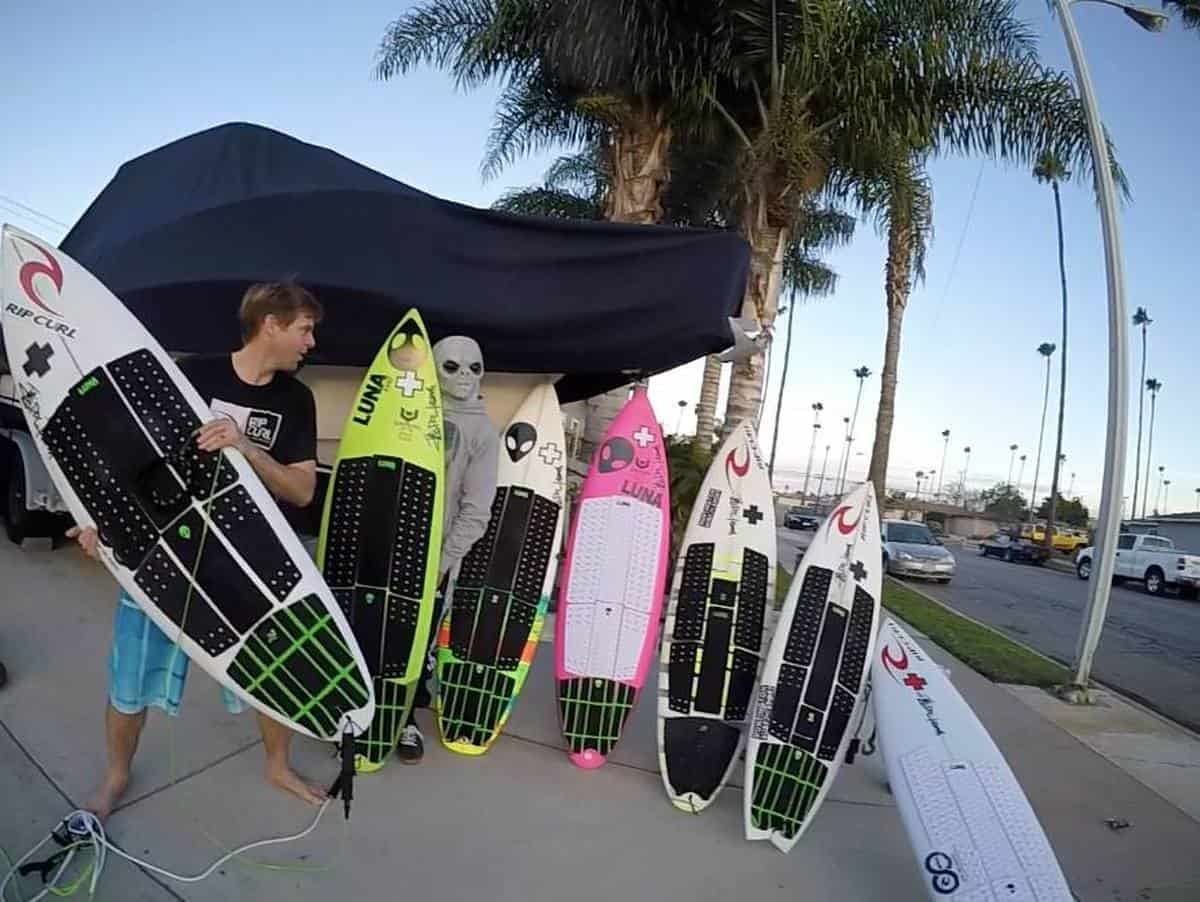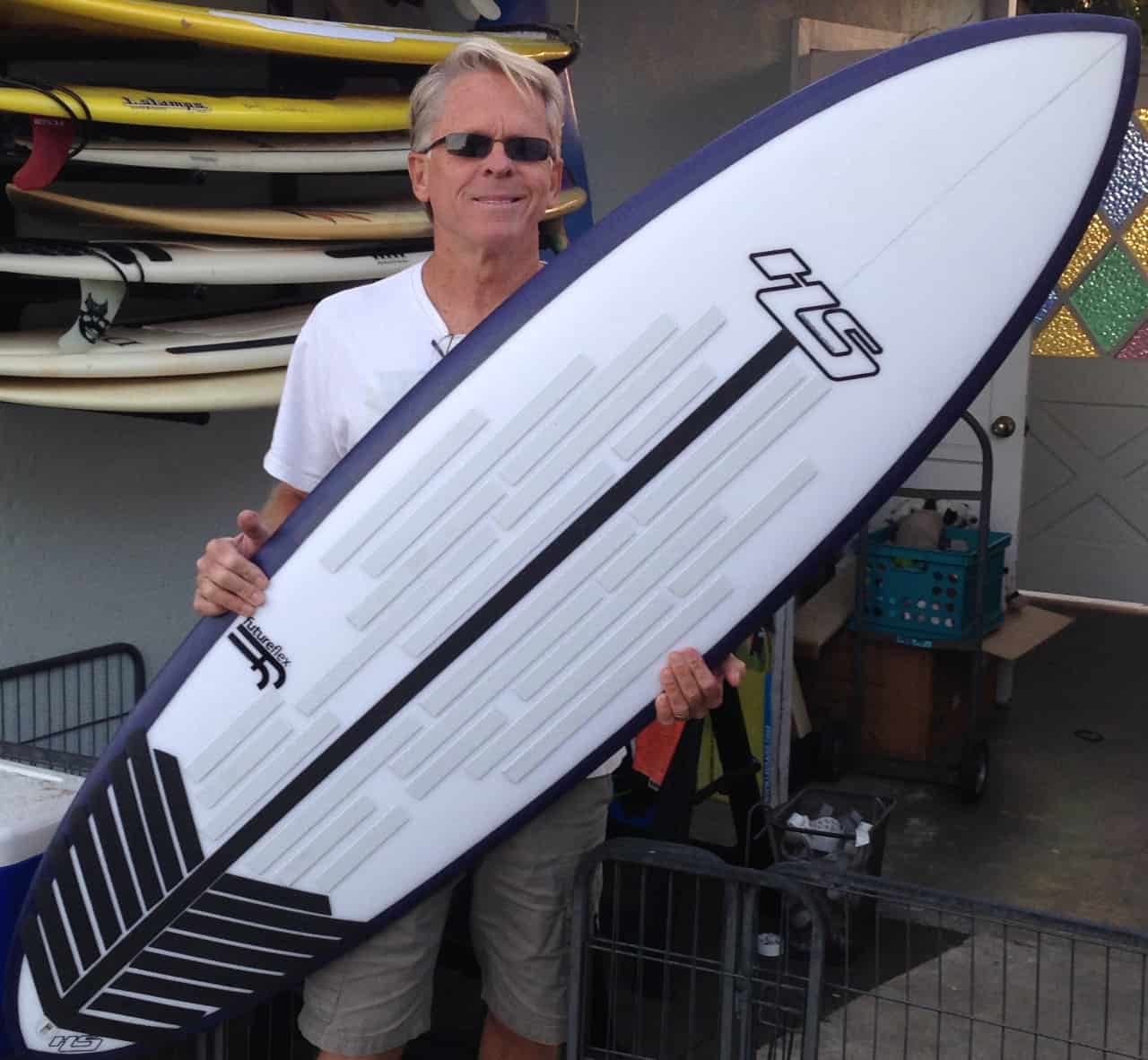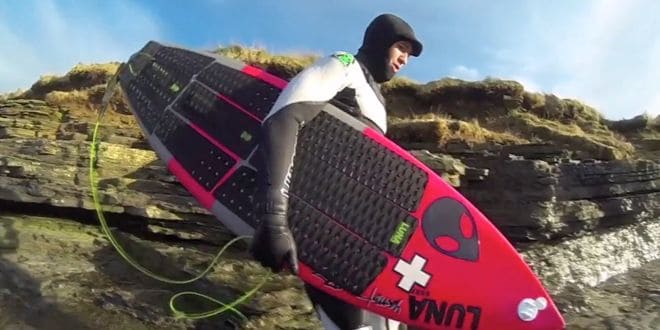Surfboard traction pads are made of a foam-like material that sticks to the tail of a surfboard. Its purpose is to prevent the back feet from sliding off the board. Surfboard wax in the right amount can also prevent the foot from sliding off. The point is some kind of grip material is needed near the tail of your surfboard.
So, do you need to have a tail pad or traction pad for surfing? You can substitute surfboard wax for a full-board traction pad, but if you use a traction pad, you’ll hardly need to wax your surfboard again if you cover your entire board.
However, using a tail pad (just at the end of a surfboard) is very useful, because your back foot will do most of the work while you’re surfing. Traction pads can provide friction that normal surf wax cannot.
What Advantages Does A Traction Pad Have?
Waxing a surfboard is time-consuming and even messy. You just first put your board out in the sun to melt off the old wax, then, scrape it, apply the new wax, and give it time to adhere to the board. Some surf enthusiasts prefer waxing instead of using a traction pad, but this is a personal preference and is no better than using a traction pad.
A surfboard needs to be waxed often (4 times a year or, for some, every time they go surfing), yet a traction pad, also known as a tail pad, lasts for the life of the surfboard. Also, many surfers love the kicktail (the raised part of the tail pad) at the back of the board because it prevents your back foot from sliding too far back. This allows you to maneuver better when standing on the board.
You can now challenge yourself on the waves, because of the extra grip you get with a traction pad. A tail pad is not a handicap; it’s a tool to help you do more. You don’t need to worry if you have enough wax on the board and worry about slippage as a wave approaches. The traction pad is there and will always be there. The kicktail allows you more control, so even aerial maneuvers are possible.
What Are The Disadvantages Of Using A Traction Pad?
There are surf purists that insist that wax is the only way to go. Some pros and older, more experienced surfers who’ve ridden waves for decades would never put a traction pad on their boards. They believe a traction pad is a handicap, and surfers are better off without them because you’ll never learn to surf if you use something that takes a challenge away.
Others insist the pad is better because it allows you to take more chances, and that a pad is merely a substitute for wax. The pad eliminates the concern that a surfer with the pad will slip when he pops off the board to position his back foot. There’s nothing wrong with something that gives you grip. Who wants the anxiety and worry of a slippery board in the middle of a ride?
The argument of purists is specious. It is not necessary to slip and fall off the board if it can be prevented. Like the invention of the surfboard itself in Hawaii, a tail pad is another invention that allows surfers to ride more waves and learn new techniques. There is nothing a wax purist can learn that a surfer with a tail pad can’t.

The only disadvantage a tail pad offers is where it’s placed on the board and how well they stick to the surfboard.
If a tail pad is placed in the wrong spot on your surfboard, it will be very difficult to remove it and put it in the right place. That’s why it’s important to place it in the right spot right away.
Using wax instead of a traction pad will allow you to place your feet in new positions that you may not have done before. A traction pad is a permanent addition to your surfboard, so you must place your foot in the same place every time unless you can change the placement of your traction pad.
You must ask yourself; do you need to have a tail pad or traction pad for surfing. If it’s something you want to try, you can remove it later, but be ready to invest an hour of work to remove it. It will come off, but there may be some markings left on the board. You’ll be able to wax over the tail when the pad is removed completely.
How Do I Remove An Old Traction Pad?
When you remove the pad, you want to get it off in one piece; removing the pad one part at a time is time-consuming and difficult and may leave glue marks behind that will take a lot more work to remove. Also, the remaining glue will delaminate the surfboard deck.
Glue weakens when exposed to high heat. If you have a blow dryer, it will assist greatly in letting you remove the traction pad in one piece.
For this project, you’ll need a razor blade or something that is sharp and has a straight edge. A steak knife is curved and serrated so it will not work.
A wax comb and paper towels are also needed. Lastly, you’ll need a chemical that helps loosen the pad and dissolve the glue that won’t damage the surfboard laminate. Mineral turpentine will work.
First, you’ll want to peel up the tail pad. Start at any corner and peel. You don’t want to tear the foam. To peel, use a single-edge razor blade or even a spackling knife and start to gently push underneath the corner. Don’t pull on the pad while you remove it because you may tear a piece off, making the removal of the rest more difficult.
Take your time. Slicing away at the glue’s residue takes time and effort. Be careful not to scrape into the surfboard. Use gentle, upward motion with the razor blade.
You can try using surfboard wax, such as Sex Wax or Sticky Bumps wax remover, instead of turpentine. Either product will help the glue lessen its adhesive properties.
Try using the blow dryer. Scrape a little under the traction pad and then stop. Apply turpentine, then go to the hair dryer. Then start again with the razor blade, getting more and more of the pad removed.
If you can’t get all of it off at once, don’t worry, Stick to this three-step process of the blade, turpentine, hair dryer until all the pieces are removed.
Once the traction pad is completely off, use the blade and scrape off the adhesive. You can use turpentine to dissolve the glue as you work. Turpentine won’t do everything, so it’s a combination of the chemical and your scraping off the glue.

Now get your paper towels and soak them with mineral turpentine. Apply it to the tail of the board over all the remaining adhesive. Leave it on for about 10 minutes and be sure to leave the soaked paper towel on the board so more of the chemical remains in contact.
After 10 minutes, take the paper towel off and get your wax comb to scrape away the rest of the glue. You’ll note most of the glue is melted by this time. If it isn’t, let the turpentine work a little longer.
Once all the glue is gone, use the same paper towel with turpentine and rub down the entire tail of the board. Next, pull off a few pieces of clean paper towels and wipe off the remaining residue of turpentine.
If you have a water hose with a nozzle, it’s a great idea to pressure wash the tail to ensure that everything has come off. Once the tail area is completely dry, you can either wax your surfboard or apply another traction pad.
You need to answer the question: do you need to have a tail pad or traction pad for surfing. Remember that a tail pad is a semi-permanent attachment to your surfboard.
Related Questions
How Do I Apply A Traction Pad To My Board?
Putting a traction pad on a surfboard is very easy to do, as long as you follow these simple steps.
- Make sure there is no glue on the tail of the surfboard.
- Cut the plastic off around the edges of the tail pad and remove the cardboard.
- Outline the area where you’ll be placing the tail pad with a pencil. Place the pad with the plastic still covering the glue on the board, position it, then trace the edges with a pencil.
- Peel off the adhesive covering the glue under the traction pad.
- Place it carefully within the tracing lines you made with the pencil.
- Press down for 30 to 40 seconds
- Keep the board out of the sun for 24 hours before using it in the surf.
Will The Traction Pad Interfere In Any Way With Surfing?
It will not interfere with your surfing. You won’t be limited by the use of a tail pad. If anything, you’ll be able to do more and take on new challenges.
Are Tail Pads For Beginners Only?
Tail pads are used by surfers at every level, beginner, intermediate and experienced. You can use tail pads in any ocean environment, from whitewater to big waves and point breaks. Pads allow you to do more without needing to wax your surfboard.

